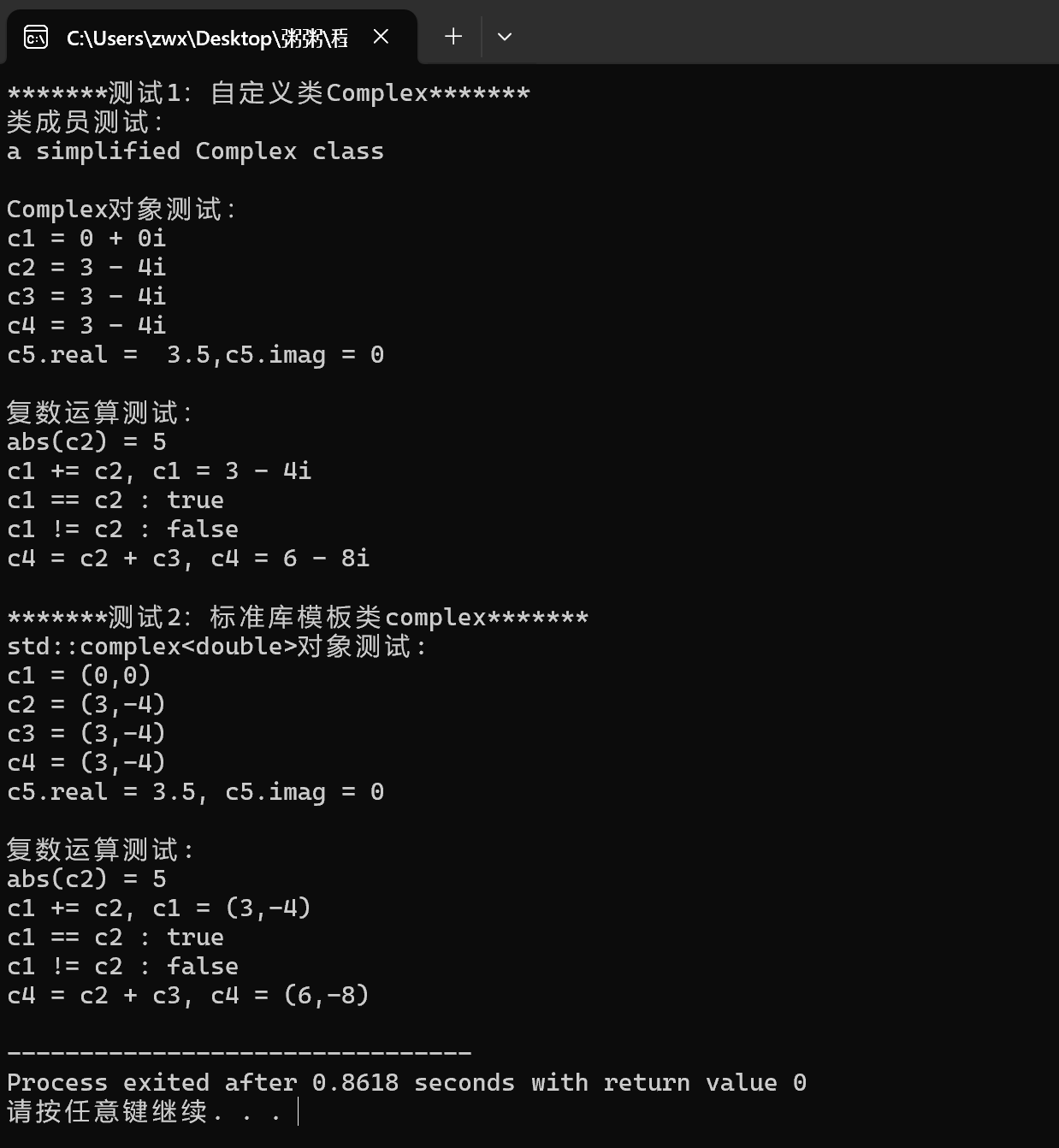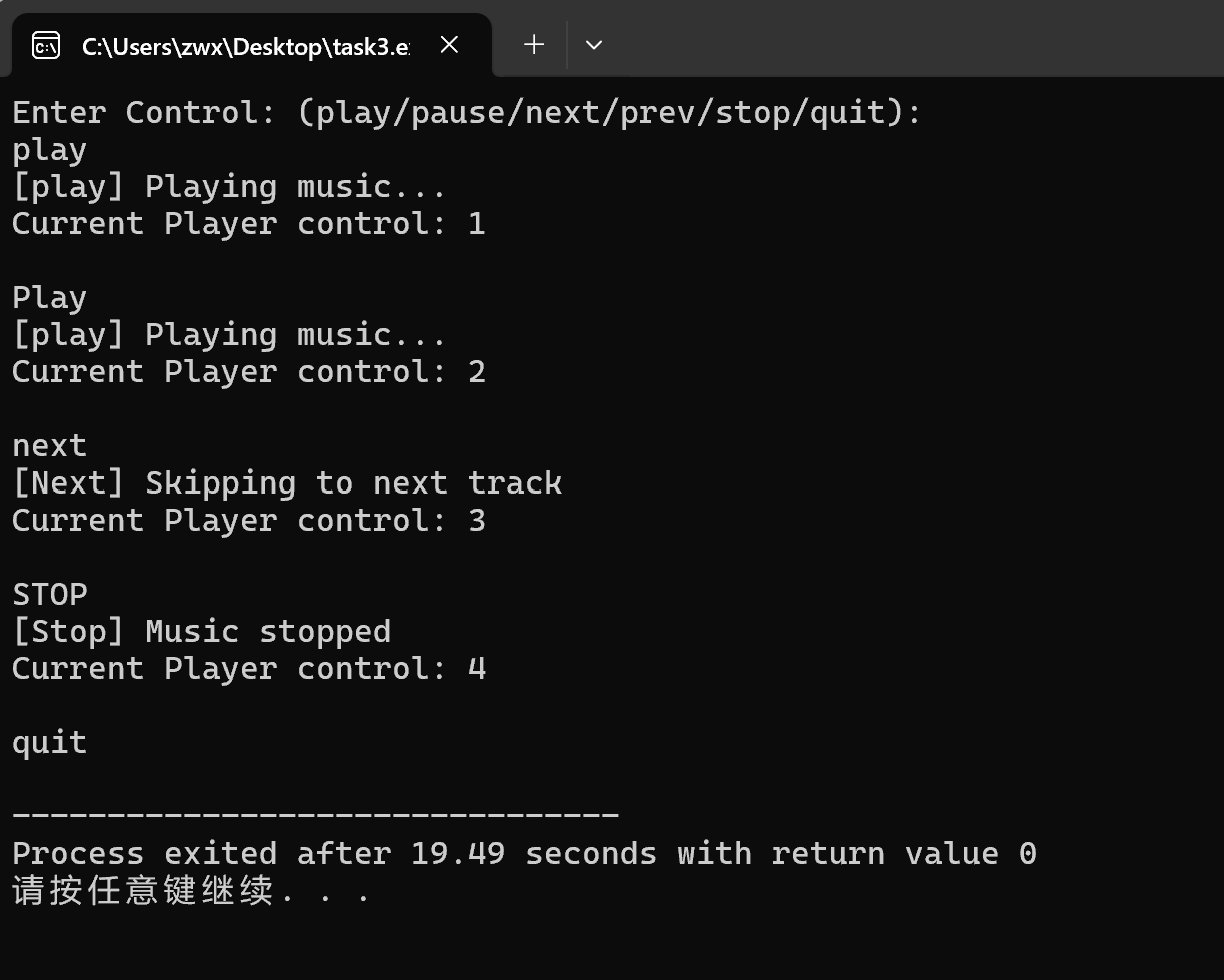OOP实验2
实验任务一:
T.h源码:
#pragma once #include<string> class T{ public: T(int x=0,int y=0); T(const T &t); T(T &&t); ~T(); void adjust(int ratio); void display() const; private: int m1,m2; public: static int get_cnt(); public: static const std::string doc; static const int max_cnt; private: static int cnt; friend void func(); }; void func();
T.cpp源码:
#include "T.h" #include<iostream> #include<string> const std::string T::doc{"a simple class sample"}; const int T::max_cnt = 999; int T::cnt = 0; //类方法 int T::get_cnt(){ return cnt; } //对象方法 T::T(int x,int y):m1{x},m2{y} { ++cnt; std::cout << "T copy constructor called.\n"; } T::T(const T &t):m1{t.m1},m2{t.m2} { ++cnt; std::cout << "T copy constructor called.\n"; } T::T(T &&t):m1{t.m1},m2{t.m2} { ++cnt; std::cout << "T move constructor called.\n"; } T::~T() { --cnt; std::cout << "T destructor called.\n"; } void T::adjust(int ratio){ m1*=ratio; m2*=ratio; } void T::display() const{ std::cout << "(" << m1 << ", " << m2 << ")"; } void func(){ T t5(42); t5.m2 = 2049; std::cout << "t5 = "; t5.display();std::cout << '\n'; }
task1.cpp源码:
#include "T.h" #include <iostream> void test_T(); int main(){ std::cout << "test Class T:\n"; test_T(); std::cout << "\ntest friend func: \n"; func(); } void test_T(){ using std::cout; using std::endl; cout << "T info: " << T::doc << endl; cout << "T objects'max count: " << T::max_cnt << endl; cout << "T objects'current count: " << T::get_cnt() << endl << endl; T t1; cout << "t1= "; t1.display() ; cout << endl; T t2(3,4); cout << "t2= "; t2.display() ; cout << endl; T t3(t2); t3.adjust(2); cout << "t3= "; t3.display() ; cout << endl; T t4(std::move(t2)); cout << "t4= "; t4.display() ; cout << endl; cout << "test: T objects'current count: " << T::get_cnt() << endl; }
运行测试结果截图:

回答问题:
问题1:T.h中,在类T内部,已声明 func 是T的友元函数。在类外部,去掉line36,重新编译,程序能否正常运行。如果能,回答YES;如果不能,以截图形式提供编译报错信息,说明原因。
答:YES。我认为是因为友元函数func只需要在类外声明并定义就可以,在T.cpp中对友元函数func已经做了定义,所以T.h中有没有声明不影响程序正常运行。
问题2:T.h中,line9-12给出了各种构造函数、析构函数。总结它们各自的功能、调用时机。
答:①普通构造函数
功能:创建类的对象,并对对象的数据成员初始化
调用时机:以直接初始化的方式创建对象时时,系统选择符合初始化参数的形参类型的普通构造函数;使用new运算符动态创建对象时
②复制构造函数
功能:创建类的对象,该对象是另一个已存在对象复制过来的副本,它会将已有对象的数据成员的值逐一复制到新创建的对象中
调用时机:参数按值传递时;使用拷贝初始化方式创建对象时
③移动构造函数
功能:创建类的对象,直接移动(相当于窃取)另一个已存在对象的数据成员至新的对象中
调用时机:使用右值引用初始化对象时
④析构函数
功能:用于在对象生命周期结束时释放对象所占用的资源
调用时机:函数执行完毕;使用delete运算符释放通过new创建的对象;容器中的元素被移除或者容器本身被销毁时
问题3: T.cpp中,line13-15,剪切到T.h的末尾,重新编译,程序能否正确编译。 如不能,以截图形式给出报错信息,分析原因。
答:能正确编译
实验任务二:
Complex.h源码:
#include<iostream> #include<string> using namespace std; //类声明 class Complex{ //类属性 public: static const string doc;//类Complex的描述信息 //对象属性、方法 private: double real,imag; public: Complex (double r=0,double i=0);//普通构造函数 Complex (const Complex &other);//复制构造函数 ~Complex ();//析构函数 //接口 public: double get_real() const; double get_imag() const; void add(Complex &other) ; //函数声明 //友元函数 friend void output(const Complex &c); friend double abs(const Complex &c); friend Complex add(const Complex &c1,const Complex &c2); friend bool is_equal(const Complex &c1,const Complex &c2); friend bool is_not_equal(const Complex &c1,const Complex &c2); };
Complex.cpp源码:
#include<iostream> #include<string> #include<cmath> #include "Complex.h" //static成员数据类外初始化 const std::string Complex::doc{"a simplified Complex class"}; //对象方法 Complex::Complex(double r,double i){ real=r,imag=i; } Complex::Complex(const Complex& other) { real = other.real; imag = other.imag; } Complex::~Complex(){}; //接口 double Complex::get_real() const { return real; } double Complex::get_imag() const { return imag; } void Complex::add(Complex &other){ real+=other.real; imag+=other.imag; } //友元函数 void output(const Complex &c){ if(c.imag >= 0) cout << c.get_real() << " + " << c.get_imag() << "i" ; else cout << c.get_real() << " - " << -c.get_imag() << "i" ; } double abs(const Complex &c){ return std::sqrt(c.real*c.real+c.imag*c.imag); } Complex add(const Complex &c1,const Complex &c2){ double real_sum=c1.get_real()+c2.get_real(); double imag_sum=c1.get_imag()+c2.get_imag(); Complex c3(real_sum,imag_sum); return c3; } bool is_equal(const Complex &c1,const Complex &c2){ return (c1.get_real()==c2.get_real()&&c1.get_imag()==c2.get_imag()); } bool is_not_equal(const Complex &c1,const Complex &c2){ return !is_equal(c1,c2); }
task2.cpp源码:
#include<iostream> #include<iomanip> #include<complex> #include "Complex.h" void test_Complex(); void test_std_complex(); int main(){ std::cout << "*******测试1:自定义类Complex*******\n"; test_Complex(); std::cout << "\n*******测试2:标准库模板类complex*******\n"; test_std_complex(); } void test_Complex(){ using std::cout; using std::endl; using std::boolalpha; cout <<"类成员测试:" <<endl; cout << Complex::doc << endl << endl; cout << "Complex对象测试:" << endl; Complex c1; Complex c2(3,-4); Complex c3(c2); Complex c4=c2; const Complex c5(3.5); cout << "c1 = ";output(c1);cout << endl; cout << "c2 = ";output(c2);cout << endl; cout << "c3 = ";output(c3);cout << endl; cout << "c4 = ";output(c4);cout << endl; cout << "c5.real = " << c5.get_real() << ",c5.imag = " << c5.get_imag() << endl << endl; cout << "复数运算测试:" << endl; cout << "abs(c2) = " << abs(c2) << endl; c1.add(c2); cout << "c1 += c2, c1 = ";output(c1);cout << endl; cout << boolalpha; cout << "c1 == c2 : " << is_equal(c1,c2) << endl; cout << "c1 != c2 : " << is_not_equal(c1,c2) << endl; c4 = add(c2,c3); cout << "c4 = c2 + c3, c4 = "; output(c4); cout << endl; } void test_std_complex() { using std::cout; using std::endl; using std::boolalpha; cout << "std::complex<double>对象测试: " << endl; std::complex<double> c1; std::complex<double> c2(3, -4); std::complex<double> c3(c2); std::complex<double> c4 = c2; const std::complex<double> c5(3.5); cout << "c1 = " << c1 << endl; cout << "c2 = " << c2 << endl; cout << "c3 = " << c3 << endl; cout << "c4 = " << c4 << endl; cout << "c5.real = " << c5.real(); cout << ", c5.imag = " << c5.imag() << endl << endl; cout << "复数运算测试: " << endl; cout << "abs(c2) = " << abs(c2) << endl; c1 += c2; cout << "c1 += c2, c1 = " << c1 << endl; cout << boolalpha; cout << "c1 == c2 : " << (c1 == c2)<< endl; cout << "c1 != c2 : " << (c1 != c2) << endl; c4 = c2 + c3; cout << "c4 = c2 + c3, c4 = " << c4 << endl; }
运行测试结果截图:

回答问题:
问题1:比较自定义类Complex和标准库模板类complex的用法,在使用形式上,哪一种更简洁?函数和运算内在有关联吗?
| 自定义类 Complex | 标准库模板类 complex |
| c1.add(c2) | c1+=c2 |
| c4=add(c2,c3) | c4=c2+c3 |
| is_equal(c1,c2) | c1==c2 |
| is_not_equal(c1,c2) | c1!=c2 |
| output(c1) | cout<<c1 |
| abs(c2) | abc(c2) |
答:(1)使用形式上标准库模板类complex更简洁,因为它的使用形式和逻辑表达式基本一致,直观简洁。
(2)函数和运算存在内在关联。自定义类Complex中,成员函数是实现运算的具体手段;而标准库模板类complex里“+=”、“==”等运算符,是通过运算符重载函数来完成运算的,本质上也是通过函数实现运算。
问题2:
2-1:自定义 Complex 中, output/abs/add/ 等均设为友元,它们真的需要访问私有数据吗?(回答“是/否”并 给出理由)
答:是。他们需要访问Complex类中的real和imag数据完成运算。
2-2:标准库 std::complex 是否把 abs 设为友元?(查阅 cppreference后回答)
答:标准库模板类complex把abs设为友元函数。

2-3:什么时候才考虑使用 friend?总结你的思考。
答:类外的函数需要使用类内私有和保护类型的数据时需要使用friend。相当于类内public对所有外部函数开放,但私有和保护的数据只对于特定的friend函数开放。
问题3: 如果构造对象时禁用=形式,即遇到 Complex c4 = c2; 编译报错,类Complex的设计应如何调整?
答:我觉得可以通过普通构造函数把c2的值传进去,或者场景允许的话直接使用移动构造函数把c2的数据给c4。因为“=”是通过拷贝构造函数复制c2产生c4,禁用拷贝构造函数后就会报错。
实验任务三:
PlayerControl.h源码:
#pragma once #include<string> enum class ControlType { Play, Pause, Next, Prev, Stop, Unknown }; class PlayerControl{ public: PlayerControl(); ControlType parse(const std::string& control_str); void execute(ControlType cmd) const; static int get_cnt(); private: static int total_cnt; };
PlayerControl.cpp源码:
#include"PlayerControl.h" #include<iostream> #include<algorithm> int PlayerControl::total_cnt=0; PlayerControl::PlayerControl() {} ControlType PlayerControl::parse(const std::string& control_str){ std::string ans; ans.reserve(control_str.size()); for(unsigned char ch:control_str) ans+=std::tolower(ch); if(ans=="play"){ total_cnt++; return ControlType::Play; } else if (ans=="pause"){ total_cnt++; return ControlType::Pause; } else if (ans=="next"){ total_cnt++; return ControlType::Next; } else if(ans=="prev"){ total_cnt++; return ControlType::Prev; } else if(ans=="stop"){ total_cnt++; return ControlType::Stop; } else{ total_cnt++; return ControlType::Unknown; } } void PlayerControl::execute(ControlType cmd) const{ switch(cmd){ case ControlType::Play: std::cout << "[play] Playing music...\n"; break; case ControlType::Pause: std::cout << "[Pause] Music paused\n"; break; case ControlType::Next: std::cout << "[Next] Skipping to next track\n"; break; case ControlType::Prev: std::cout << "[Prev] Back to previous track\n"; break; case ControlType::Stop: std::cout << "[Stop] Music stopped\n"; break; default: std::cout << "[Error] unknown control\n"; break; } } int PlayerControl::get_cnt(){ return total_cnt; }
task3.cpp源码:
#include "PlayerControl.h" #include <iostream> void test() { PlayerControl controller; std::string control_str; std::cout << "Enter Control: (play/pause/next/prev/stop/quit):\n"; while(std::cin >> control_str) { if(control_str == "quit") break; ControlType cmd = controller.parse(control_str); controller.execute(cmd); std::cout << "Current Player control: " << PlayerControl::get_cnt() << "\n\n"; } } int main() { test(); }
运行测试结果截图:

实验任务四:
Fraction.h源码:
#pragma once #include <string> using namespace std; class Fraction { public: static const string doc; Fraction(int up = 0, int down = 1); Fraction(const Fraction& other); int get_up() const; int get_down() const; Fraction negative() const; friend void output(const Fraction& f); friend Fraction add(const Fraction& f1, const Fraction& f2); friend Fraction sub(const Fraction& f1, const Fraction& f2); friend Fraction mul(const Fraction& f1, const Fraction& f2); friend Fraction div(const Fraction& f1, const Fraction& f2); private: int up; int down; void reduce(); };
Fraction.cpp源码:
#include "Fraction.h" #include <iostream> #include <string> using namespace std; const std::string Fraction::doc = "Fraction类 v 0.01版.\n目前仅支持分数对象的构造、输出、加/减/乘/除运算."; int gcd(int a, int b) { a = abs(a); b = abs(b); while (b != 0) { int temp = b; b = a % b; a = temp; } return a; } Fraction::Fraction(int up, int down) : up(up), down(down) { if(down==0){ cout << "分母不能为0" << endl; this->up = 0; this->down = 1; } else{ reduce(); } } Fraction::Fraction(const Fraction& other) : up(other.up), down(other.down) {} int Fraction::get_up() const { return up; } int Fraction::get_down() const { return down; } Fraction Fraction::negative() const { return Fraction(-up, down); } void Fraction::reduce() { if (up == 0) { down = 1; return; } int gcd_val = gcd(abs(up), abs(down)); up /= gcd_val; down /= gcd_val; if (down < 0) { up = -up; down = -down; } } void output(const Fraction& f) { if(f.down==1) cout << f.up ; else cout << f.up << "/" << f.down; } Fraction add(const Fraction& f1, const Fraction& f2) { int new_up = f1.up * f2.down + f2.up * f1.down; int new_down = f1.down * f2.down; if(new_up==0) { return 0; } else{ Fraction res(new_up, new_down); res.reduce(); return res; } } Fraction sub(const Fraction& f1, const Fraction& f2) { int new_up = f1.up * f2.down - f2.up * f1.down; int new_down = f1.down * f2.down; Fraction res(new_up, new_down); res.reduce(); return res; } Fraction mul(const Fraction& f1, const Fraction& f2) { int new_up = f1.up * f2.up; int new_down = f1.down * f2.down; Fraction res(new_up, new_down); res.reduce(); return res; } Fraction div(const Fraction& f1, const Fraction& f2) { if (f2.up == 0) { cerr << "分母不能为0" << endl; return Fraction(0, 1); } int new_up = f1.up * f2.down; int new_down = f1.down * f2.up; Fraction res(new_up, new_down); res.reduce(); return res; }
task4.cpp源码:
#include"Fraction.h" #include<iostream> void test1(); void test2(); int main() { std::cout << "测试1: Fraction类基础功能测试\n"; test1(); std::cout << "\n测试2: 分母为0测试: \n"; test2(); } void test1() { using std::cout; using std::endl; cout << "Fraction类测试: " << endl; cout << Fraction::doc << endl << endl; Fraction f1(5); Fraction f2(3, -4), f3(-18, 12); Fraction f4(f3); cout << "f1 = "; output(f1); cout << endl; cout << "f2 = "; output(f2); cout << endl; cout << "f3 = "; output(f3); cout << endl; cout << "f4 = "; output(f4); cout << endl; const Fraction f5(f4.negative()); cout << "f5 = "; output(f5); cout << endl; cout << "f5.get_up() = " << f5.get_up() << ", f5.get_down() = " << f5.get_down() << endl; cout << "f1 + f2 = "; output(add(f1, f2)); cout << endl; cout << "f1 - f2 = "; output(sub(f1, f2)); cout << endl; cout << "f1 * f2 = "; output(mul(f1, f2)); cout << endl; cout << "f1 / f2 = "; output(div(f1, f2)); cout << endl; cout << "f4 + f5 = "; output(add(f4, f5)); cout << endl; } void test2() { using std::cout; using std::endl; Fraction f6(42, 55), f7(0, 3); cout << "f6 = "; output(f6); cout << endl; cout << "f7 = "; output(f7); cout << endl; cout << "f6 / f7 = "; output(div(f6, f7)); cout << endl; }
运行测试结果截图:

回答问题:
问题:分数的输出和计算, output/add/sub/mul/div ,你选择的是哪一种设计方案?(友元/自由函数/命名空间+自 由函数/类+static) 你的决策理由?如友元方案的优缺点、静态成员函数方案的适用场景、命名空间方案的考虑因素等。
答:我选择的方案是友元函数。决策理由是它能直接访问分数类的私有成员,简化了逻辑、提升了效率;虽然友元存在破坏封装、扩展性弱的缺点,但对于本次实验很实用,而静态成员函数更适合逻辑性、扩展性强的场景,命名空间+自由函数则多用于多模块命场景。



 浙公网安备 33010602011771号
浙公网安备 33010602011771号